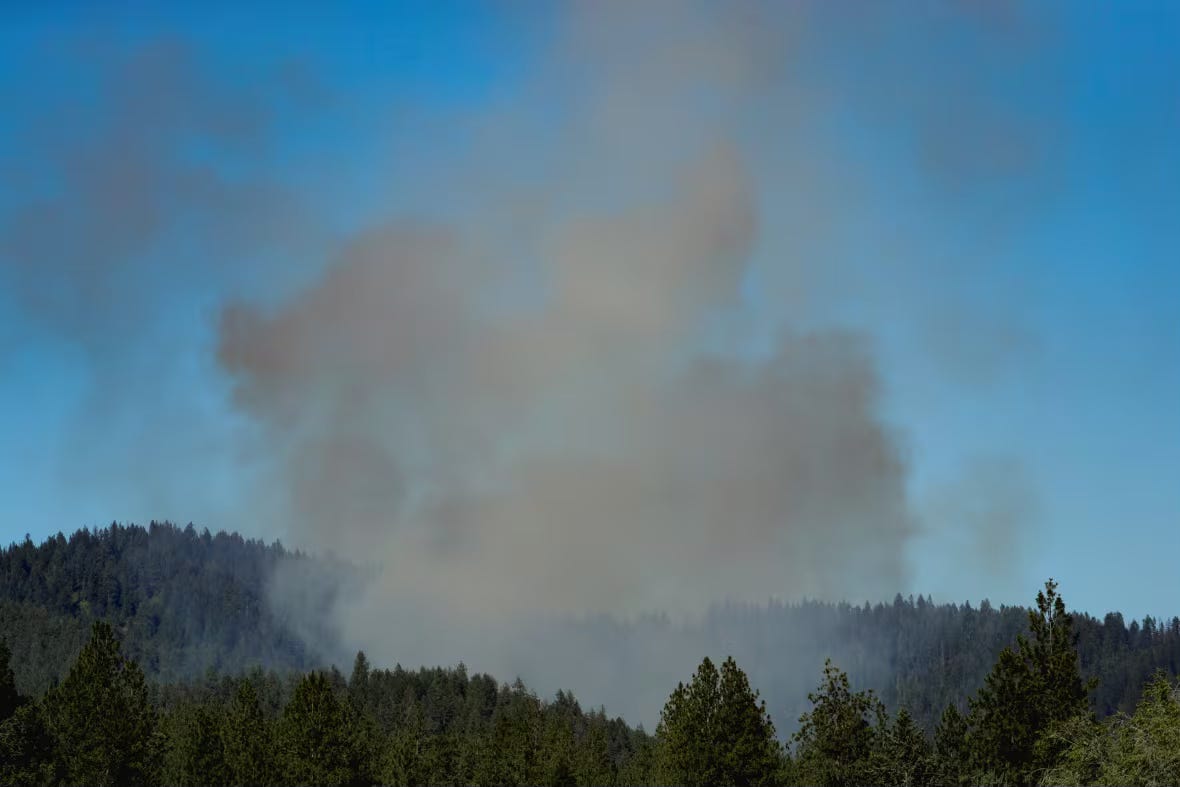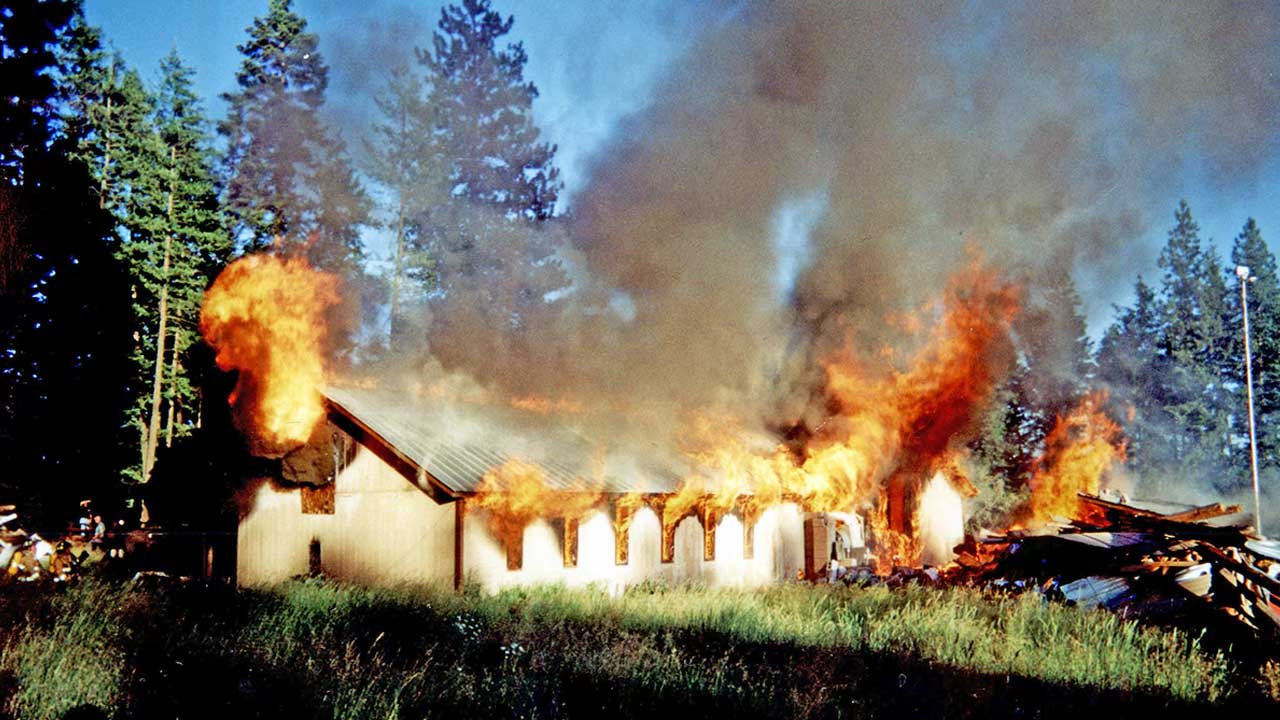Ambush on the Mountain: How a Fire Call Turned Deadly in Northern Idaho
Two firefighters are dead, one injured, and a community shaken after an unprecedented sniper-style ambush unfolded on the slopes of Canfield Mountain in Coeur d’Alene.
The Call That Turned Fatal
At approximately 1:20 p.m. on June 29, emergency dispatchers received a call reporting a brush fire in a rugged section of Canfield Mountain near the Nettleton Gulch Trailhead. Wildfires aren’t uncommon in this part of Idaho, and fire crews from Kootenai County responded quickly. But this wasn’t a normal call.
Roughly 30 minutes after arrival, as firefighters began suppression efforts, sniper fire erupted from an unseen location in the trees. Within minutes, two firefighters were struck and killed. A third was critically wounded and rushed to a local hospital.
Scanner audio captured the moment chaos broke out:
“There’s an active shooter zone! They’re shot down. BC3’s down, BC1’s down. Everybody’s shot up here… Engine Brush 551, do not come up here.”
A Coordinated Response, and a Growing Mystery
Law enforcement from local, state, and federal agencies quickly converged on the area. A shelter-in-place order was issued for neighborhoods near the mountain, while police warned civilians and hikers to stay clear. Tactical teams—including the FBI’s Hostage Rescue Team and aerial thermal surveillance units—swept the forested terrain.
Sheriff Bob Norris confirmed to reporters that his deputies were still “actively taking sniper fire” well into the afternoon.
Another live scanner quote:
“LEOs and FFs are ACTIVELY taking sniper fire… mass casualty… FBI assets are on scene.”
By early evening, the shooter’s body was discovered near a rifle and tactical gear. The suspect, believed to be acting alone, was found deceased from a gunshot wound. Officials have not confirmed whether it was self-inflicted or the result of return fire.
Event Timeline
1:20 p.m. First fire call for a brush fire on Canfield Mountain near Coeur d’Alene.
2:00 p.m. Firefighters arrive on scene. — Roughly 30 minutes later, sniper fire begins. 2:00–2:30 p.m. Gunman—believed to be lone shooter—opens fire using a high-powered rifle, killing two firefighters and seriously wounding a third. Firefighters and law enforcement come under fire; crews pull back.
After 2:30 p.m. Scanner chatter reports mass casualty conditions and calls for law enforcement backup.
5:00 p.m. Sheriff Norris confirms “actively taking sniper fire”; unknown number of shooters initially.
Late afternoon Shelter-in-place order issued; civilian evacuations underway as fire continues to spread.
Evening Suspect found dead with a firearm nearby. Search concludes; shelter-in-place lifted.
Post-event Fire crews resume suppression; investigation into motive and suspect identity ongoing.
Live Scanner Quotes
From Reddit r/masskillers and r/Wildfire users listening to Broadcastify and scanner apps:
“Multiple firefighters down. Radio scanner saying units are down and calling for LEOs… fire reportedly intentionally set as a trap.”
— user “Substantial_Smell260” in r/Wildfire“2 dead, unknown number of casualties… LEOs and FFs are ACTIVELY taking sniper fire.”
— “AccentedE” on r/masskillers quoting scanner“There’s an active shooter zone! They’re shot down. BC3’s down, BC1’s down. Everybody’s shot up here… Engine brush 551, do not come up here.”
— quoted by “Distinct_External” on r/masskillers
These real-time clips confirm immediate chaos, multiple casualties, and ongoing sniper fire, forcing firefighters to pull back.
Deliberate Trap: Fire Set to Lure Responders
Authorities now say the wildfire was intentionally ignited as a diversion—a calculated trap meant to lure firefighters into an ambush zone.
“There’s no doubt in our minds this was deliberate,” said one law enforcement source. “This wasn’t a spontaneous act of violence. It was planned.”
The fire, dubbed the Nettleton Gulch Fire, burned through 20 acres before suppression efforts resumed late Sunday evening. Firefighting was temporarily halted during the active shooting.
Motive Still Unknown — But Speculation Swirls
The identity of the shooter has not yet been released, pending autopsy and next-of-kin notification. However, theories are swirling across social media.
Some users on Reddit and X (formerly Twitter) have pointed out that June 29 marked the 24th anniversary of a controversial event in the region’s far-right history: in 2001, firefighters and police demolished a building owned by the Aryan Nations, once headquartered near Hayden Lake—just miles away.
“24 years ago yesterday firefighters burned down Aryan Nations property… This could be retaliation,” one widely-shared post speculated.
Others suspect possible ties to anti-government extremism or radicalization through online channels, but no evidence of ideology or manifesto has been released. Authorities have neither confirmed nor denied a connection to extremist groups.
Smoke and Shadows: The Legacy of Aryan Nations and the Fire That Ended Their Reign
As investigators probe the motive behind the deadly Canfield Mountain ambush that killed two Idaho firefighters, some are asking whether the date—June 29—and the location bear a deeper historical significance. That same date, 24 years earlier, marked the symbolic end of one of America’s most notorious hate groups: the Aryan Nations. Was the shooting an eerie coincidence, or does it echo the unfinished rage of a fallen extremist movement?
Who Were the Aryan Nations?
The Aryan Nations was a white supremacist and neo-Nazi organization founded by Richard Girnt Butler in the 1970s. Influenced by Christian Identity theology—a radical belief system that claimed white Europeans were God’s chosen people—the group quickly became a magnet for militant racists, Holocaust deniers, and paramilitary survivalists.
Their compound, described by the Southern Poverty Law Center as a “terrorist training camp,” sat on 20 acres of wooded land in Hayden Lake, Idaho, just 10 miles north of Coeur d’Alene.
During the 1980s and 90s, the Aryan Nations hosted annual gatherings drawing hundreds of white nationalists and fringe militia groups. The group was linked—directly and indirectly—to violent plots, bank robberies, and even assassination attempts, including associations with members of The Order, a far-right terrorist cell that carried out murders and bombings.
The Lawsuit That Burned Down the Compound
The Aryan Nations’ downfall began not with an FBI raid, but a civil lawsuit brought by a mother and son—Victoria and Jason Keenan—in 1998. The two were driving past the Hayden Lake compound when guards from Aryan Nations, believing they were intruders, chased and fired upon them, eventually running them off the road and holding them at gunpoint.
With the help of the Southern Poverty Law Center, the Keenans sued Richard Butler for negligence. In 2000, a jury awarded the family $6.3 million, bankrupting the organization.
“It was the first major financial blow to a white supremacist organization using civil law,” said SPLC co-founder Morris Dees at the time.
The Aryan Nations compound was seized, and ownership transferred to the Keenans. With support from human rights advocates, the buildings were bulldozed and burned on June 29, 2001—exactly 24 years to the day before the 2025 Coeur d’Alene sniper attack.
Location Relevance: Hayden Lake and Canfield Mountain
The original Aryan Nations compound was located off Rimrock Road near Hayden Lake—just 6 to 7 miles northeast of Canfield Mountain, where firefighters were ambushed this week.
While there’s no confirmed connection between the shooter and any surviving Aryan Nations members, some online theorists have noted the proximity and symbolic date:
“It’s almost too precise to ignore—June 29 was the day Aryan Nations burned, and now we have a mass killing of first responders in the same woods? Something feels deliberate.” — X user @RightWatch
Indeed, several former affiliates of the Aryan Nations remained active in North Idaho for years after the compound’s destruction, though the group as an organized force has been largely defunct.
Is There a Connection to the Canfield Ambush?
As of July 1, law enforcement has not publicly linked the Coeur d’Alene shooter to Aryan Nations or any extremist movement. The shooter’s identity has yet to be released, and no manifesto or ideology has been found.
Still, the timing and location have drawn attention, particularly among researchers familiar with domestic extremism.
Date match: June 29, 2001 – compound destroyed
June 29, 2025 – firefighters ambushed
Location: Both in the Coeur d’Alene–Hayden Lake corridor, within 10 miles
If the shooting was ideologically motivated, it may represent a lone actor’s attempt to avenge the symbolic death of the Aryan Nations, or it may simply be a tragic coincidence. Until the shooter’s identity and background are made public, the theory remains speculative.
Legacy of Hate, or Shadow of Coincidence?
North Idaho has struggled for decades to shake off its reputation as a haven for white supremacist movements. While the region today is far more diverse and less tolerant of extremist ideologies, isolated pockets of hate persist.
“The Aryan Nations may be gone in name, but the embers of that ideology still flicker in the Pacific Northwest,” said Dr. Kathleen Belew, historian and expert on white power movements.
Whether the Canfield ambush is connected to that legacy or not, it has reopened old wounds and stirred old fears in a region still healing from its past.
The burning of the Aryan Nations compound on June 29, 2001, was hailed as a victory for civil society and a decisive blow to white supremacy. But on June 29, 2025, flames rose again on the same soil—not from a hate compound, but from a fire set to kill the very people who protect the public.
Until investigators confirm otherwise, we may never know whether the shooter’s motives were historical, ideological, or personal. But in North Idaho, the ghosts of the past are never far from the treeline.
The Travis Decker Conspiracy and the Coeur d’Alene Wildfire Ambush
Travis Caleb Decker, 32, is a former Army and National Guard soldier currently wanted in Washington State for the suspected murder of his three young daughters, whose bodies were discovered in early June near his abandoned vehicle in Leavenworth, Washington.
Decker has been missing since the incident, and authorities have launched an extensive multi‑agency search—though investigators now acknowledge he may no longer be alive .
How the Theory Surfaced
Following the June 29 ambush of firefighters on Canfield Mountain, social media users began immediately asking:
“Where is Travis Decker?”
“Could this be Travis Decker?”
“Is this Travis Decker?”
These questions spread across X, Reddit, and Facebook, often accompanied by concern that U.S. Marshals were present on the scene—implying a link to Decker, as marshals have been confirmed assisting in his manhunt .
Why Decker Was Considered
Military & survival background – Decker served in Afghanistan and has survival and navigation training; rumored to have lived off-grid and capable of extended wilderness evasion.
Timing and proximity – His disappearance in early June, coupled with the ambush at a nearby Idaho locale weeks later, sparked suspicion.
Public speculation – Users cited Decker's training and described him as “willing to do the impossible” and “highly trained”.
What the Evidence Says (So Far)
No official link: Authorities in Idaho and Washington have not confirmed any connection between Decker and the Coeur d’Alene ambush.
Search ongoing: The Kittitas County Sheriff’s Office emphasizes that there's no definitive proof Decker is alive or in Idaho, though they continue investigations for both cases.
Marshals’ presence: While the U.S. Marshals are confirmed searching for Decker, there’s no authenticated information that they were involved in Idaho during the shooting incident.
To date, no credible evidence ties Travis Decker to the Coeur d’Alene shooting. While his background and disappearance made him a social media talking point, official sources have rejected any confirmed connection. The theory remains wild speculation—not supported by investigative findings.
What’s Confirmed So Far
2 firefighters killed, 1 injured (now in stable condition after surgery)
Deliberately set wildfire used to lure first responders
Lone gunman found dead, believed responsible for the ambush
No additional suspects currently being sought
Fire suppression resumed, and shelter-in-place orders lifted
Aftermath and Next Steps
Gov. Brad Little has ordered flags lowered to half-staff and released a statement calling the attack “a cowardly act of violence against Idaho’s bravest.” Memorial efforts for the fallen firefighters are underway, and a fund for their families has already raised tens of thousands online.
The FBI and Kootenai County Sheriff’s Office continue to investigate the shooter’s background and motive.
“This wasn’t just an act of violence,” said Sheriff Norris. “It was an attack on the very people who run toward danger to protect others.”
What happened on Canfield Mountain has stunned the firefighting and law enforcement communities. It marks one of the deadliest targeted attacks on first responders in recent Idaho history—and perhaps, the nation’s. Until the shooter’s identity and motive are fully understood, the community is left to grieve, and to question how an act so calculated could happen under the cover of smoke.






